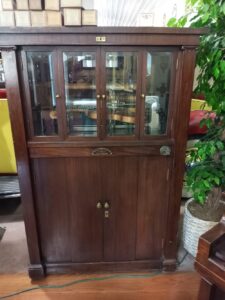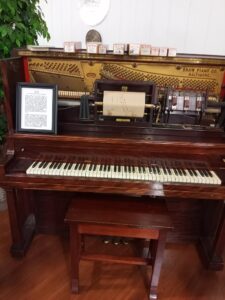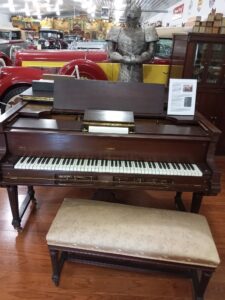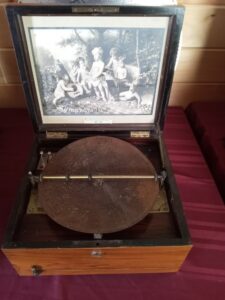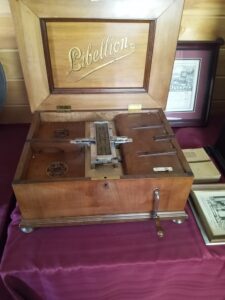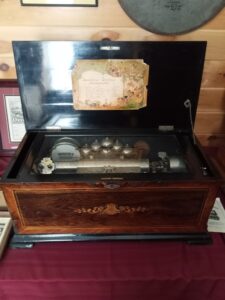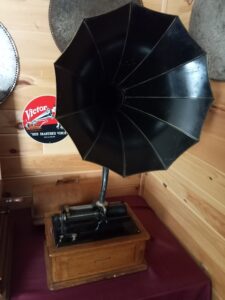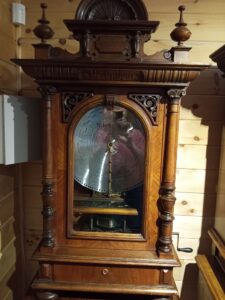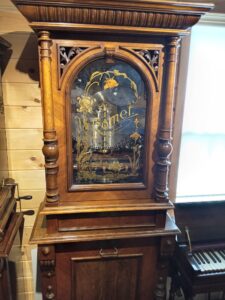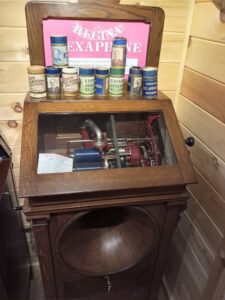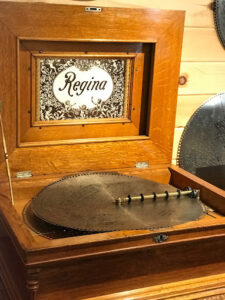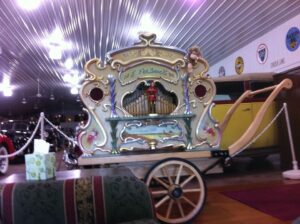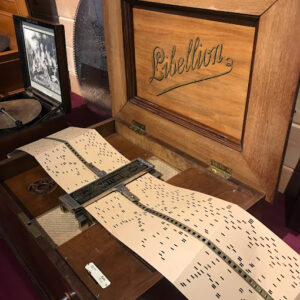Organs and Music Boxes
112 Key Mortier Jazz Orchestrion
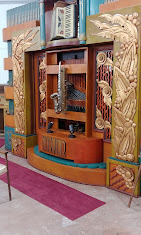 This organ was built by the Mortier organ company in the late 1930’s. It was built to take advantage of the modern music popular in dance halls throughout Europe – JAZZ. The pipes in the organ are constructed in such a way for the organ to simulate a jazz orchestra.
This organ was built by the Mortier organ company in the late 1930’s. It was built to take advantage of the modern music popular in dance halls throughout Europe – JAZZ. The pipes in the organ are constructed in such a way for the organ to simulate a jazz orchestra.
The front of organ features an “Electrosax” built by Mortier. In the 1930’s organ builders started to introduce more animation to the organs. The accordian on top was also a favorite addition to these large cafe organs. The Electrosax does not actually play the saxophone solos the organ is capable of. A set of eighteen saxophone voiced pipes directly behind the saxophone create the sound.
80 Key Mortier Portable Dance Hall Organ
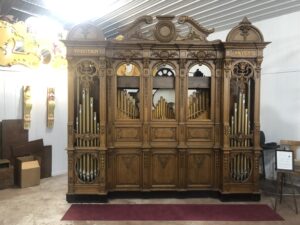 Theodore Mortier produced “dance” organs such as this “classic” model between 1908 and 1930, this organ was most likely built sometime between 1908 and 1914. The organ, despite its formidable size, is indeed built to be a portable organ for use in traveling shows.
Theodore Mortier produced “dance” organs such as this “classic” model between 1908 and 1930, this organ was most likely built sometime between 1908 and 1914. The organ, despite its formidable size, is indeed built to be a portable organ for use in traveling shows.
The organ has 80 “keys” that are controlled by the folding cardboard music books. There are 4 registers of 8 bass notes, 10 accompaniment notes, 23 melody notes and 18 countermelody notes for a total of 59 keys used for note playing. The remaining 21 keys are used to give the organ and the arrangers who compose the music the ability to turn on and off the different pipe registers to create the wide array of sounds or voices that these organs can play. The pipe registers are meant to create the sound of trombones, cellos, and violins. Additionally, there is a xylophone, bass drum, snare drum, cymbol, wood block, and castanet in the percussion section.
84 Key Mortier Style L Orchestrion
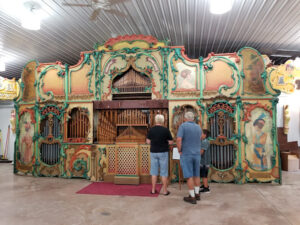 Theofiel Mortier produced organs and orchestrions such as this for many years starting at the turn of the twentieth century. This is an organ of circa 1916. At his factory in Antwerp Belgium is where Mortier was known to have created some 1000 organs and orchestrions between 1900 and 1952 when the business was liquidated.
Theofiel Mortier produced organs and orchestrions such as this for many years starting at the turn of the twentieth century. This is an organ of circa 1916. At his factory in Antwerp Belgium is where Mortier was known to have created some 1000 organs and orchestrions between 1900 and 1952 when the business was liquidated.
This is an 84 key machine which refers to the signals used to create the music in the music books used to create the unique musical effects. In addition to the pipes the orchestrion has a bass and snare drums as well as a wood block and triangle to augment the pipes. Perhaps most important of all is the unique way in which Mortier controlled the sound and attack of the pipes within their respective registries. The various ranks of pipes are switched on and off to create different voices and effects throughout the performance of any given song.
61 Key Verbeeck Fairground Organ
 This large fairground organ was built in 1921 in Birmingham England by Jimmy Verbeeck of the Verbeeck organ-building family. This large organ was used in the Hatwell Brothers traveling circus’s steam-driven carousel ride. The organ was sold at auction in 1986 to Masami Tawara who later founded Cranker’s Collection of Mechanical Marvels.
This large fairground organ was built in 1921 in Birmingham England by Jimmy Verbeeck of the Verbeeck organ-building family. This large organ was used in the Hatwell Brothers traveling circus’s steam-driven carousel ride. The organ was sold at auction in 1986 to Masami Tawara who later founded Cranker’s Collection of Mechanical Marvels.
The organ has 61 keys or signals to drive 256 pipes, percussion effects and register controls used to make music. Noteworthy on this organ are the violin pipes used in the melody section of the instrument. The pipes are switched on and off by the automatic register control perforations in the music book.
Music Boxes and Player Pianos
Mechanical music instruments include a Symphonion No. 48 table-top disc musical box with eight bar bells, a 19-5/8” Polyphon upright coin-operated disc musical box, an 8-air “Tambour, Timbres & Castagnettes” orchestral cylinder box by Mermod Freres, a 54-tooth Libellion folding cardboard book playing musical box, a 12-bell Komet upright disc musical box and a 20-3/4” Style 28 Regina table-top musical box with a gallery top.
